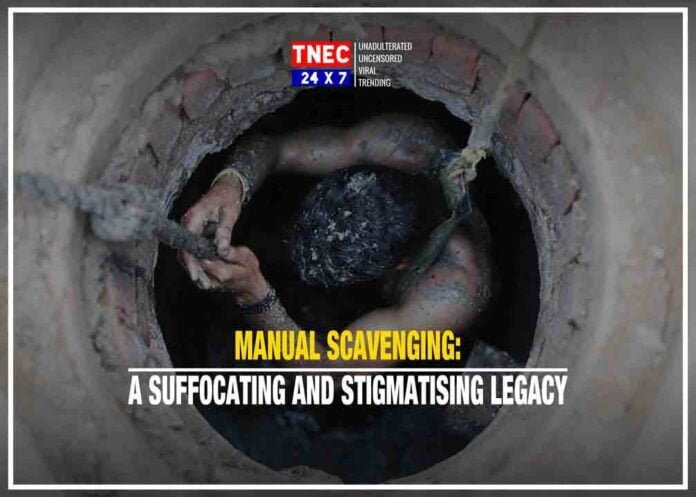By: Sneha Singha, The North-Eastern Chronicle
Visual by: Harmeet Singh
Hundreds of manual scavengers die every year as a result of hazardous fumes. I know what you are thinking right now ‘Wasn’t it illegal to perform manual scavenging in India?’ With the passing of the Employment of Manual Scavengers and Construction of Dry Latrines (Prohibition) Act, 1993, manual scavenging was outlawed for several years, yet it still exists.
What is Manual Scavenging?

Scavenging is the manual cleansing of human excrement from service/dry latrines. The scavengers enter the dry latrines with their bare hands and collect the human excrement, carrying it as a head load in a container for
disposal.
Manual scavenging in India
South Asians in many regions are still cleaning human waste out of dry toilets and open drains by hand. To this day, in many parts of India, women from traditionally “manual scavenger” groups gather human waste on a daily basis, put it into cane baskets or metal troughs, and then carry it away on their heads for disposal outside the community, as has been the practice from ancient times.
Since India’s independence in 1947, the national government has taken legislative and policy steps to eradicate manual scavenging. Some of these commitments, made in recent years, include plans to upgrade sanitation so that human waste no longer requires manual disposal and prohibitions on hiring anyone to perform this labour.
Because these policies aren’t well implemented, people aren’t aware of their right to decline this job, and those who refuse may be subjected to tremendous social pressure, including physical threats and deportation from their village, frequently with the collaboration of local government officials.
Manual scavengers typically come from lower-caste families who have been assigned to menial jobs that are despised by upper-caste relatives. Their caste-designated work reinforces the societal stigma that they are dirty or “untouchable” and fosters wide-spread prejudice. Males and women remove faeces from open defecation sites, gutters, and drains, with the exception of men, who perform the physically taxing task of cleaning sewers and septic tanks, which is more common among the male population.
On September 6, 2013, the Indian Parliament approved the Prohibition of Employment as Manual Scavengers and Their Rehabilitation Act, 2013 (the 2013 Act), reaffirming its commitment to eliminate manual scavenging.
Seven months later, on March 27, 2014, the Indian Supreme Court ruled that India’s constitution mandates the state to intervene to put an end to manual scavenging and “rehabilitate” all those involved in it. This meant that not only was manual scavenging outlawed, but so were the abuses that affected the communities that used it.
In 2013, the government acknowledged the historically rooted and ongoing unfairness suffered by communities involved in manual scavenging, which is essential, but also refers to shortcomings in the implementation of past laws and policies to address the issue.
Recent examples from manual scavenging communities in Gujarat, Madhya Pradesh, Maharashtra, Rajasthan, and Uttar Pradesh highlight the failures of previous government attempts to end manual scavenging and eliminate the entrenched attitudes and discriminatory practices that still bind members of affected communities to this degrading and pointless occupation.
Several women who wanted to abandon manual scavenging told Human Rights Watch that even when they received threats from the houses they served, local authorities refused to interfere. They were denied access to community land and resources or threatened with eviction as a result of their departure, often with the support of village councils and other officials.
Using technology to put an end to manual scavenging
Around 15 ideas have apparently been developed across the country to replace manual scavenging. According to reports, the Hyderabad Metropolitan Water Supply and Sewerage Board is clearing clogged sewer pipes with 70 micro jetting machines that can access narrow roads and smaller communities. A group of engineers in Thiruvananthapuram has created a spider-shaped robot that cleans manholes and sewers with precision.
While technology is deemed critical to eradicating this problem, Ashif Shaikh, the founder of Jan Sahas social development organisation, believes that relying solely on technological solutions to eliminate manual scavenging may not be effective. “It is a social and gender issue and can be eradicated by sensitising people about its ills.
In 2012-13, we launched a nationwide march covering 200 districts across 18 states. Our objective was to make women aware of their right to live with dignity. We managed to liberate some 6,000 women during that yatra, and so far, we have liberated about 30,000 scavengers,” Shaikh tells Down To Earth.












